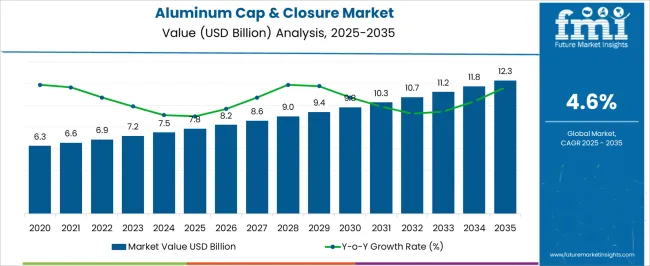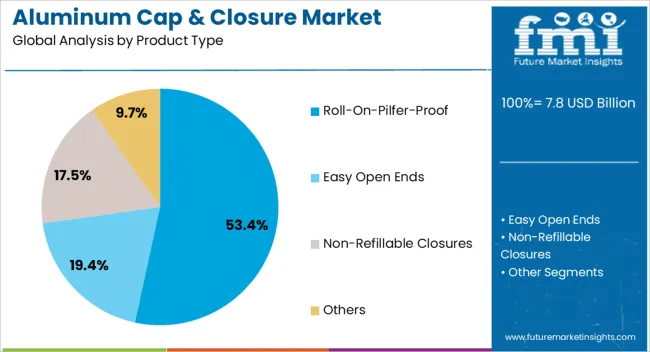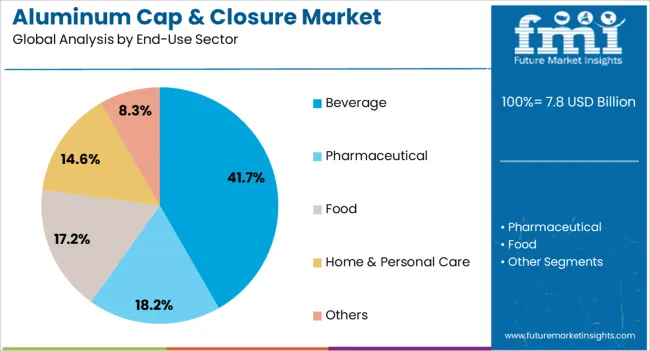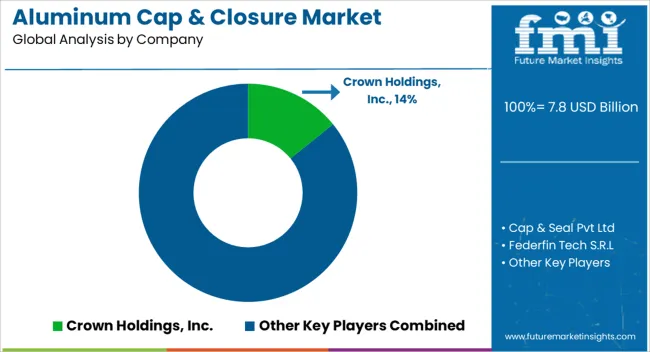Aluminum Cap & Closure Market Size and Share Forecast Outlook 2025 to 2035
The Aluminum Cap & Closure Market is estimated to be valued at USD 7.8 billion in 2025 and is projected to reach USD 12.3 billion by 2035, registering a compound annual growth rate (CAGR) of 4.6% over the forecast period.
The aluminum cap and closure market is witnessing strong growth, fueled by expanding beverage consumption, rising packaging hygiene standards, and increasing adoption of premium and tamper-evident closures. The material’s lightweight nature, corrosion resistance, and high recyclability have positioned it as a preferred choice across industries seeking sustainable packaging solutions.
The current market environment reflects a shift toward recyclable aluminum packaging to meet circular economy goals and reduce plastic dependency. Technological advancements in closure design, coupled with improved sealing performance, have further enhanced product value.
Growth in bottled water, alcoholic beverages, and pharmaceutical packaging segments continues to underpin market expansion. With favorable regulations promoting aluminum recycling and increasing preference for resealable, consumer-friendly closures, the outlook remains highly positive over the forecast period.
Quick Stats for Aluminum Cap & Closure Market
- Aluminum Cap & Closure Market Industry Value (2025): USD 7.8 billion
- Aluminum Cap & Closure Market Forecast Value (2035): USD 12.3 billion
- Aluminum Cap & Closure Market Forecast CAGR: 4.6%
- Leading Segment in Aluminum Cap & Closure Market in 2025: Roll-On-Pilfer-Proof (53.4%)
- Key Growth Region in Aluminum Cap & Closure Market: North America, Asia-Pacific, Europe
- Top Key Players in Aluminum Cap & Closure Market: Crown Holdings, Inc., Cap & Seal Pvt Ltd, Federfin Tech S.R.L, Silgan Holdings, Amcor, Guala Closure, Herti JSC, Alcopack, Torrent Closures

| Metric |
Value |
| Aluminum Cap & Closure Market Estimated Value in (2025 E) |
USD 7.8 billion |
| Aluminum Cap & Closure Market Forecast Value in (2035 F) |
USD 12.3 billion |
| Forecast CAGR (2025 to 2035) |
4.6% |
Segmental Analysis
The market is segmented by Product Type and End-Use Sector and region. By Product Type, the market is divided into Roll-On-Pilfer-Proof, Easy Open Ends, Non-Refillable Closures, and Others. In terms of End-Use Sector, the market is classified into Beverage, Pharmaceutical, Food, Home & Personal Care, and Others. Regionally, the market is classified into North America, Latin America, Western Europe, Eastern Europe, Balkan & Baltic Countries, Russia & Belarus, Central Asia, East Asia, South Asia & Pacific, and the Middle East & Africa.
Insights into the Roll-On-Pilfer-Proof Segment

The roll-on-pilfer-proof (ROPP) segment dominates the product type category, holding approximately 53.4% share of the aluminum cap and closure market. Its widespread application in wine, spirits, and carbonated beverage packaging is attributed to its tamper-evident design, reliability, and ease of resealing.
The segment benefits from advancements in precision manufacturing, enabling consistent sealing and compatibility with automated filling lines. Growing demand for enhanced packaging security and authenticity verification in the beverage industry has reinforced adoption.
ROPP closures also offer brand differentiation opportunities through embossing and decorative finishes. As beverage manufacturers emphasize product safety, convenience, and sustainability, the roll-on-pilfer-proof segment is expected to maintain its strong market presence throughout the forecast period.
Insights into the Beverage Segment

The beverage segment leads the end-use sector, representing approximately 41.7% share of the aluminum cap and closure market. Rising consumption of bottled water, soft drinks, and alcoholic beverages has driven the need for reliable, tamper-proof closures that preserve carbonation and flavor.
Aluminum’s lightweight and recyclable nature aligns with sustainability targets set by leading beverage producers. The segment has also benefited from the premiumization of beverages, where packaging aesthetics play a vital role in brand positioning.
Expanding urban populations, changing consumption habits, and increasing demand for convenience packaging are further stimulating growth. With continued innovation in closure functionality and design, the beverage segment is expected to retain its dominant position across global markets.
Lucrative Opportunities Driving Demand Growth in the Aluminum Cap & Closure Market
- With the increasing awareness and concern about environmental issues, there is a growing demand for eco-friendly packaging solutions that can reduce waste and carbon footprint.
- Aluminum closures are recyclable and can be used multiple times, making them an ideal choice for sustainable packaging.
- With the increasing competition in the market, companies are looking for ways to differentiate their products from others, propelling demand for premium packaging solutions.
- The use of high-quality aluminum closures can help companies enhance the perceived value of their products and create a premium image in the minds of consumers.
- The emergence of eCommerce is also creating new opportunities for market players in the aluminum cap & closure market.
- With the growing trend of online shopping, companies are looking for packaging solutions that can protect their products during transit.
- Aluminum closures can provide the required protection and ensure that the products reach consumers in good condition.
- Market players can leverage these opportunities to expand their business and gain a competitive advantage in the market.
Key Restraints Impacting the Growth of the Aluminum Cap & Closure Industry
- With the growing number of players in the market, companies need to focus on product innovation, quality, and pricing to remain competitive.
- The increasing pressure to reduce costs while maintaining quality is another challenge that companies face.
- The fluctuating prices of aluminum and other materials used to manufacture caps and closures can vary widely depending on global supply and demand trends.
- This can make it difficult for companies to predict their costs and plans for the future.
- Regulatory compliance is another challenge that companies face.
- As governments around the world continue to introduce new regulations and standards related to packaging materials, companies must ensure that their products comply with these regulations.
- This can involve significant investment in testing and certification, which can be a burden for smaller players in the market.
Aluminum Cap & Closure Industry Analysis by Top Investment Segments
The Roll-On-Pilfer-Proof Segment Dominates the Market by Product Type
| Attributes |
Details |
| Product Type |
Roll-On-Pilfer-Proof |
| CAGR (2025 to 2035) |
4.5% |
- This type of closure consists of a plastic insert with a rolling ball that can be easily applied to the bottle's neck, providing an airtight seal that prevents leakage and contamination.
- The unique design provides a tamper-evident feature, which drives the product demand.
- The pilfer-proof feature ensures that the product remains intact and secure during transportation and storage.
- This makes it an ideal choice for packaging industries, especially for pharmaceuticals, food, and beverage industries, where product safety and integrity are of utmost importance.
- The convenience of use, easy application, and cost-effectiveness of roll-on-pilfer-proof closures have made them a popular choice for consumers as well.
The Beverage Segment Dominates the Market by End-Use Sector
| Attributes |
Details |
| End-Use Sector |
Beverage |
| CAGR (2025 to 2035) |
4.4% |
- The demand for bottled beverages has been on the rise in recent years. This has led to an increase in demand for aluminum caps and closures, as they provide a secure and airtight seal for beverages.
- Aluminum caps and closures offer several advantages over other materials, such as plastic or cork. They are lightweight, durable, and can be easily recycled.
- They provide excellent protection against oxygen and moisture, which helps to preserve the freshness and quality of beverages.
- Aluminum caps and closures are widely used in the beverage industry due to their compatibility with different types of containers and filling machines.
Analysis of Top Countries Manufacturing, Certifying, and Operating Aluminum Cap & Closure Products
| Countries |
CAGR (2025 to 2035) |
| United States |
4.9% |
| United Kingdom |
5.8% |
| China |
5.3% |
| Japan |
5.1% |
| South Korea |
6.0% |
Growing Awareness among Consumers about Sustainability and Environmental Concerns in the United States
- The growing packaging industry in the country is driving the market forward.
- With the rise of eCommerce and online shopping, the demand for efficient and secure packaging has also increased.
- Aluminum caps and closures provide a reliable and safe packaging solution for various products such as beverages, pharmaceuticals, personal care products, and more.
- The increasing demand for aluminum caps and closures in the United States is due to the growing awareness among consumers about sustainability and environmental concerns.
- Aluminum is a highly recyclable material that can be recycled infinitely without losing its quality. This makes it an eco-friendly and sustainable choice for packaging, which is becoming increasingly important for consumers.
Rising Awareness Regarding Eco-friendly Environment in the United Kingdom
- The increasing awareness among consumers about the environmental impact of packaging materials is bolstering product demand.
- The United Kingdom has set ambitious targets to reduce plastic waste, and this has led to a shift towards more sustainable packaging solutions such as aluminum caps and closures.
- With the increasing energy demand in the United Kingdom, the industry is constantly looking for ways to improve efficiency and reduce costs.
- The United Kingdom has a robust manufacturing industry, and the demand for aluminum caps and closures has led to a rise in the production of these products.
- The country has well-established infrastructure and logistics networks that make it easy for companies to import and export goods.
- This has made it easier for manufacturers to distribute their products across the country and beyond.
Improved Manufacturing Capabilities in China
- China is the world's most populous country and has a rapidly growing middle class. As people's incomes rise, they tend to consume more packaged goods, including beverages and food items, which require caps and closures.
- The growth of eCommerce in China has led to an increase in demand for packaging materials, including aluminum caps and closures.
- China has also become a major producer of aluminum caps and closures.
- The country's manufacturing capabilities have improved significantly, and it now has a large number of companies that specialize in manufacturing these products.
- This has led to increased competition and lower prices for consumers.
- The Chinese government has been investing heavily in infrastructure and urbanization.
- The construction of new buildings, transportation systems, and other infrastructure projects requires a significant amount of aluminum, which has contributed to the growth of the aluminum industry in China.
Increasing Beverage Industry in Japan
- The growth of the beverage industry in Japan has led to an increased demand for aluminum caps and closures for bottles.
- Aluminum caps and closures are popular in the beverage industry due to their lightweight and easy-to-use design, as well as their ability to maintain the freshness of the contents.
- The increasing popularity of online shopping has also contributed to the growth of the aluminum cap & closure market in Japan.
- As more people turn to online shopping, the demand for packaging materials, including aluminum caps and closures, has increased.
- This is because online retailers need to ensure that their products are packaged safely and securely for shipping and delivery.
- Aluminum is a highly recyclable material, and as more companies in Japan prioritize sustainable practices, the demand for aluminum caps and closures has increased, focusing on sustainability.
Rising Pharmaceutical Industry in South Korea
- The pharmaceutical industry in South Korea has contributed to the demand for aluminum caps and closures.
- The use of aluminum packaging for medicines and drugs has become increasingly popular due to its durability and ability to protect the contents from external factors such as moisture and air. This has led to an increase in demand for aluminum caps and closures in the pharmaceutical industry.
- South Korea's growing economy and rising disposable income have led to an increase in consumer spending.
- This has resulted in a higher demand for packaged goods, including food, beverages, and cosmetics, which also use aluminum caps and closures.
- As a result, the aluminum cap & closure market in South Korea is expected to continue to grow in the coming years.
Competitive Landscape of the Aluminum Cap & Closure Market

The aluminum cap and closure market is highly competitive, with many players offering a wide range of products and services. Companies have a strong presence in the market owing to their extensive distribution networks, innovative product offerings, and strong brand recognition.
However, smaller players are also gaining traction. Overall, the market is expected to grow in the coming years, as demand for high-quality and sustainable packaging solutions continues to rise.
Recent Development:
- In 2020, Crown Food Europe, a subsidiary of Crown Holdings, unveiled a new package of capping solutions that promises to reduce the total cost of ownership for food manufacturers. The package comprises the sale of its capping technology, ancillary components, and expert technical support for the machines during their service life.
Leading Companies Profiled in the Aluminum Cap & Closure Market Report
- Crown Holdings, Inc.
- Cap & Seal Pvt Ltd
- Federfin Tech S.R.L
- Silgan Holdings
- Amcor
- Guala Closure
- Herti JSC
- Alcopack
- Torrent Closures
Top Segments Studied in the Aluminum Cap & Closure Market Report
By Product Type:
- Roll-On-Pilfer-Proof
- Easy open ends
- Non-refillable closures
- Others
By End-Use Sector:
- Beverage
- Pharmaceutical
- Food
- Home & personal care
- Others
By Region:
- North America
- Latin America
- East Asia
- South Asia
- Europe
- Oceania
- MEA
Frequently Asked Questions
How big is the aluminum cap & closure market in 2025?
The global aluminum cap & closure market is estimated to be valued at USD 7.8 billion in 2025.
What will be the size of aluminum cap & closure market in 2035?
The market size for the aluminum cap & closure market is projected to reach USD 12.3 billion by 2035.
How much will be the aluminum cap & closure market growth between 2025 and 2035?
The aluminum cap & closure market is expected to grow at a 4.6% CAGR between 2025 and 2035.
What are the key product types in the aluminum cap & closure market?
The key product types in aluminum cap & closure market are roll-on-pilfer-proof, easy open ends, non-refillable closures and others.
Which end-use sector segment to contribute significant share in the aluminum cap & closure market in 2025?
In terms of end-use sector, beverage segment to command 41.7% share in the aluminum cap & closure market in 2025.










